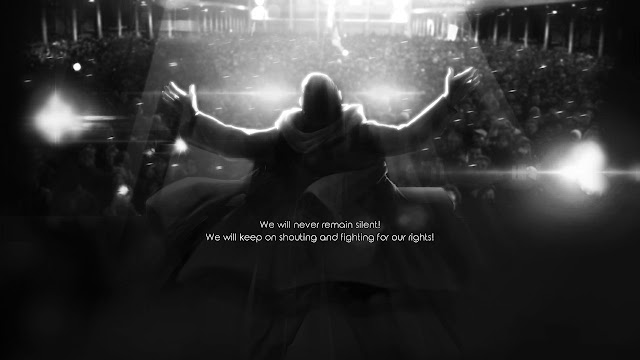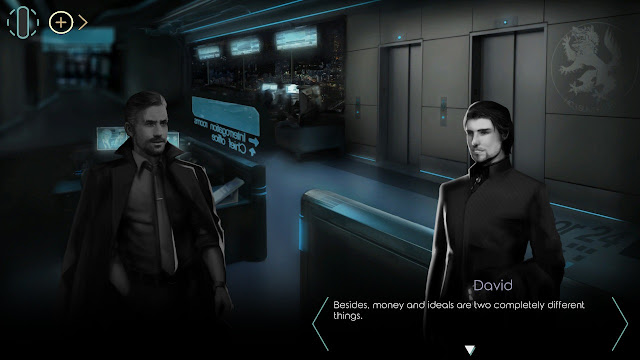Why did no one tell me about Dry Drowning before? It is very much my kind of experience. It’s thought-provoking, has a solid grounding in literary tradition, and weaves a gripping narrative. Looking through some of the other reviews that have popped up since the game launched on PC back in 2019, it would seem that there are a lot of people that are unfamiliar with the noir… on any level, so perhaps that’s why Dry Drowning didn’t get the attention it deserved, but it is one of the best applications of that genre since Raymond Chandler himself.
Dry Drowning takes place in an isolated city-state that has cut itself off from the rest of the world, and it has doubled down, hard, on fascism. The ruling party are outright Nazis that plan to persecute foreigners in the way that the Nazis did, and paranoia and tension run high through society, since every person is documented and monitored, Internet use is restricted, and many of the police are on the take. You play as a private detective who, in true noir fashion, is a morally compromised former cop-turned criminal, and you’re thrust deep into a truly horrific series of murders that are being perpetrated by a serial killer that enjoys arranging his victims up though they’re the performance of some of his favourite Greek myths.
There’s so much to unpack in just this. From the top: though the game was released in 2019, it is such an astute (and quite overt) observation from an Italian developer on the fascistic tendencies of many western democracies. The city-state of Dry Drowning does indeed hold free and open elections, with the game’s writers explicitly arguing that in modern times, fascistic tendencies don’t occur exclusively in single-party dictatorships. Early on the leader of the more overly fascist party is potentially arrested and imprisoned (depending on your own actions in investigating the crime that he’s accused of) and makes a speech that is a near 1:1 prediction of Trump’s speeches in rallying up the support he needed for his little march on the capital earlier this year. Perhaps most poignantly, there’s no indication that things are going to get better with the “moderate” party in power, and that, I feel, is the real crux of what the developer is saying in this politically-loaded game.
Then there’s the panopticon, or surveillance state themes. Dry Drowning is science fiction – it takes place in a future where holograms are used to recreate murder scenes, and there are giant screens everywhere, blearing advertisements directly into the eyes of the consumers. It’s also a world where the powers-that-be have taken control of that technology and use it to their own ends – retaining control and making sure that every person knows that they’re being monitored. Sometimes it’s subtle – there’s an industry in-joke early on where the protagonist deadpan muses over how weird it is that a popular game is being used by the authorities to track movements and behaviours of players. At other times, technology is so pervasive and linked to the authorities that everyone knows they’re being watched. It is as Foucault once wrote in describing the panopticon: “Is it surprising that prisons resemble factories, schools, barracks, hospitals, which all resemble prisons?” In a society that wretched, the behaviour of the serial killer almost behaves as a response and resistance to such oppression; a vile resistance, to be sure, but Dry Drowning is a dark, dark game.
In fact, while Dry Drowning might lack cybernetic implants, it comes across as so much more “cyberpunk” than certain other recent attempts at the genre. Technology infuses and overpowers every aspect of life, and power and corruption at the top run deep. This is a game that is fundamentally critical of the elite, makes transgression against social norms core to many of its characters, and is aggressive in the promotion of its themes. The thematic crossovers between noir and punk are many, of course, but it’s good to see a game actually follow through, as uncomfortable as it might make some audiences, and not simply play on it as an aesthetic.
Really, the only part of Dry Drowning that took me a while to be fully on board with was the aesthetics. The black-and-white character models, while appropriate for the noir genre, don’t fill the screen in the way that I might have liked, and they do clash with the vibrantly coloured backgrounds. Those, too, are accurate to the genre, but there’s a dissonance between the characters and environment which clashes more than it compliments. That being said, the more I got into the game, the more that impression faded – I still think the patchwork approach wasn’t the right one to take – but there’s a vivid imagination about the overall game which makes locations distinct and characters evocative. Those moments where Dry Drowning does cut scenes and full-scale art are truly high-impact, too. I’m hoping the development team can return to these kinds of ideas with a slightly expanded budget and a little more experience under their belts, because even the weakest element, the art, is just a half-step away from crossing that elusive threshold to become something visionary.
Dry Drowning reminds me a little of another game that I went into with absolutely no expectations, and went on to become one of my favourite games of all time: Tokyo Dark: Remembrance. Both are heavily inspired by noir and horror elements, though Tokyo Dark is Lovecraftian and Dry Drowning is more cyberpunk. Both games share a bold willingness to discomfort the audience, an interest in social commentary relevant to the real world, and an unrelenting intensity and urgency in the storytelling. I very nearly missed Dry Drowning because it very much looks like the low-budget visual novel that many other critics have accused it of being. I’m not sure what they were playing, though, because if you actually listen to what the game’s saying, and pay attention to the literary genres that it belongs to, this is really quite a remarkable experience.










